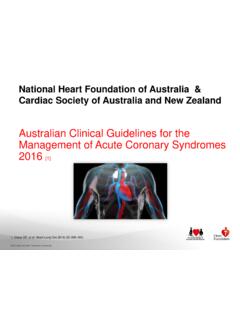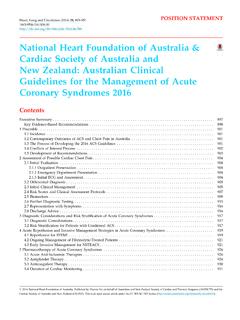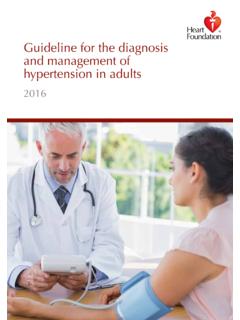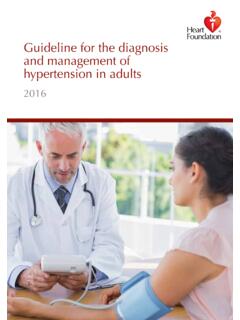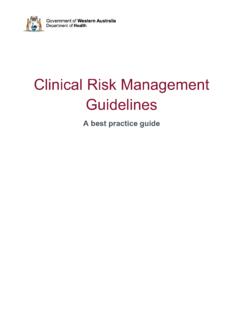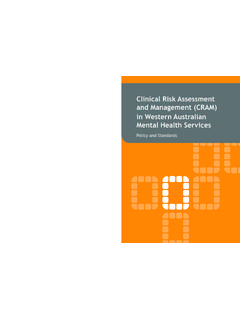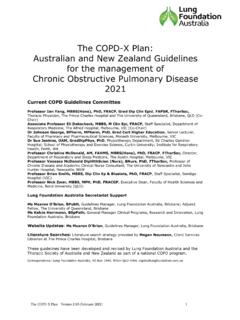Transcription of Guidelines for the management of Absolute …
1 Guidelines for the management ofAbsolute cardiovascular disease riskAn initiative of the National Vascular disease Prevention Alliance2 About the National Vascular disease Prevention Alliance The National Vascular disease Prevention Alliance (NVDPA) is an alliance of four leading and well-known australian charities: Diabetes Australia, the National Heart Foundation of Australia, Kidney Health Australia and the National Stroke 2000, these four charities began to work together to reduce the burden of cardiovascular disease in Australia. Much of the work of the NVDPA to date has been to promote the use of an Absolute risk approach to predicting risk of cardiovascular disease . The NVDPA advocates to government and professional bodies for a health system that supports an Absolute risk approach. The NVDPA aims to raise awareness among health professionals to use Absolute risk assessment in their everyday for the management of Absolute cardiovascular disease risk National Vascular disease Prevention AllianceEndorsed byPublication approvalThese Guidelines were approved by the Chief Executive Officer of the National Health and Medical Research Council (NHMRC) on 27 April 2012, under Section 14A of the National Health and Medical Research Council Act 1992.
2 In approving these Guidelines the NHMRC considers that they meet the NHMRC standard for clinical practice Guidelines . This approval is valid for a period of 5 is satisfied that they are based on the systematic identification and synthesis of the best available scientific evidence and make clear recommendations for health professionals practising in an australian health care setting. The NHMRC expects that all Guidelines will be reviewed no less than once every five publication reflects the views of the authors and not necessarily the views of the australian document is a general guide to appropriate practice, to be followed subject to the circumstances, clinician s judgement and patient s preferences in each individual case. The Guidelines are designed to provide information to assist decision making and are based on the best available evidence at the time of development.
3 The relevance and appropriateness of the information and recommendations in this document depend on individual circumstances. Moreover, the recommendations and Guidelines are subject to change over time. While all care has been taken in preparing the content of this material, the National Vascular disease Prevention Alliance and the funding body expressly disclaims and accepts no responsibility for any undesirable consequences arising from relying on the information or recommendations contained National Stroke Foundation, on behalf of the National Vascular disease Alliance, gratefully acknowledges the financial assistance provided by the australian Government Department of Health and Ageing. The Department did not have editorial rights in the development of the Guidelines and this publication reflects the views of the authors and not necessarily the views of the australian citationNational Vascular disease Prevention Alliance.
4 Guidelines for the management of Absolute cardiovascular disease risk. : 978-0-9872830-1-6 National Stroke Foundation information and resources are available summary 06 Summary of recommendations 10 Introduction Purpose 16 Scope 16 Target audience 17 Development 17 Revision of the Guidelines 17 Funding body 17 Chapter 1: Assessment and review of CVD risk Potential benefits of Absolute CVD risk assessment Taking a clinical history Measuring risk factors Assessing Absolute CVD risk Assessment of CVD risk in different populations Clinically determined high risk General population Aboriginal and Torres Strait Islander peoples Populations requiring special consideration Review of CVD risk 28 Chapter 2.
5 Treatment Lifestyle Nutrition, overweight and obesity Physical activity Smoking Alcohol Multiple lifestyle interventions Pharmacotherapy Blood pressure-lowering therapy Lipid-lowering therapy Antiplatelet therapy Pharmacological approaches to simultaneously lower blood pressure and lipids Initiation and maintenance of pharmacotherapy Blood pressure lowering therapy Lipid-lowering therapy Principles of pharmacological therapy Populations requiring special consideration People with diabetes People with CKD 62 Chapter 3: Monitoring of pharmacotherapy Maximising the benefits of pharmacotherapy Patient adherence 65 Appendices1.
6 Guidelines development groups and terms of reference 672. Guidelines development process report 723. Economic considerations 904. Assessment and management summary 1035. Recommendations for future research 108 Glossary and abbreviations 110 Bibliography 1136In Australia, 64% of the adult population have three or more modifiable risk As CVD is largely preventable, an approach focusing on comprehensive risk assessment will enable effective management of identified modifiable risk factors through lifestyle changes and, where needed, pharmacological therapy.
7 Absolute CVD risk in the context of these Guidelines refers to the likelihood of a person experiencing a cardiovascular event within the next five years. These Guidelines incorporate the previous Guidelines for the Assessment of Absolute cardiovascular disease Risk10 and provide additional guidance on the management of CVD risk in a primary prevention setting in all adults over 45 years of age (35 years for people of Aboriginal or Torres Strait Islander [A&TSI] decent)Although the goal for management of Absolute CVD risk is to reduce the level of Absolute risk (AR) in the person, this is achieved by management of multiple individual risk factors. Individual risk factors such as high blood pressure (BP) and raised lipid levels have been shown to have a continuous association with the risk of CVD events; therefore, moderate reductions in several risk factors may be more effective in reducing overall CVD risk than a major reduction in one Decisions regarding management of risk are therefore made according to the individual s AR level, while response to treatment is monitored by measurement of individual risk factors.
8 The algorithms and table on pages 7-9 provide a summary of the recommended assessment pathway, interventions, targets and follow-up. Executive summaryAssessment of cardiovascular disease (CVD) risk on the basis of the combined effect of multiple risk factors ( Absolute CVD risk) is more accurate than the use of individual risk factors, because the cumulative effects of multiple risk factors may be additive or Assessment and management Algorithm: Adults aged 45 years and over without known history of CVDA lready known to be at increased risk?Adults with any of the following conditions do not require Absolute CVD risk assessment using the Framingham Risk Equation because they are already known to be at clinically determined high risk of CVD: (EBR: Grade D) Diabetes and age >60 years Diabetes with microalbuminuria (> 20 mcg/min or urinary albumin:creatinine ratio > mg/mmol for males, > mg/ mmol for females) Moderate or severe chronic kidney disease (persistent proteinuria or estimated glomerular filtration raterate [eGFR] <45 mL/ m2) A previous diagnosis of familial hypercholesterolaemia Systolic blood pressure 180 mmHg or diastolic blood pressure 110 mmHg Serum total cholesterol > mmol/LEBR: Evidence-based recommendation (Graded A-D) CBR: Consensus-based recommendation PP.
9 Practice pointConduct formal Absolute risk assessmentYESNOYESHigh: greater than 15% risk of CVD within the next 5 years (includes clinically determined high risk) (PP)Calculate risk level using Framingham Risk Equation (EBR: Grade B): australian cardiovascular risk charts Web calculator Enter age 74 for adults aged 74+ (CBR)Moderate: 10-15% risk of CVD within the next 5 years (PP)Low: less than 10% risk of CVD within the next 5 years (PP)Provide lifestyle advice and support (CBR)Provide lifestyle advice (CBR)Is BP persistently 160/100 mmHg?Is one of the following present? BP persistently 160/100 mmHg Family history of premature CVD South Asian, Middle Eastern, Maori or Pacific Islander peoples Identify all other risk factors Continue with lifestyle intervention (CBR) Treat for BP and/or lipid lowering (CBR)Monitor and review risk at 3-6 months (CBR)Has risk improved?
10 Monitor individual risk factor response to treatment (PP)Monitor response (PP) Treat BP (CBR) Continue with lifestyle advice (CBR)Review Absolute risk according to clinical context (PP)Review Absolute risk in 6-12 months (PP)Review Absolute risk in 6-12 months (PP)Review Absolute risk in 2 years (PP)Monitor response (PP)Monitor response (PP)Continue with lifestyle intervention (CBR)Consider treating for BP and/or lipid-lowering (CBR) Provide frequent and sustained lifestyle advice, support and follow-up (CBR) Commence BP + lipid lowering therapy unless contraindicated or clinically inappropriate (EBR: Grade B)NOYESNOYESNO8 Risk Assessment and management Algorithm: Aboriginal and Torres Strait Islander adults aged 35 years and over without known history of CVDC onduct formal Absolute risk assessmentNOYESHigh: greater than 15% risk of CVD within the next 5 years (includes clinically determined high risk) (PP)Calculate risk level using Framingham Risk Equation (EBR: Grade B): australian cardiovascular risk charts Web calculator : 10-15% risk of CVD within the next 5 years (PP)Low.

